Thursday 27 October 2022
An update on ep group’s evolution
At ep group we are best known for our work in energy efficiency, energy services, and the financing of energy efficiency. This work is based on both our experience over many years but also our belief that improving energy efficiency is a critical but still relatively neglected part of the energy transition. We have always been clear, however, that transitioning to a cleaner, more equitable energy system is just one part of the massive challenge we all face in building a more sustainable, and ultimately regenerative economy. Every day, as well as the effects of climate change we see more evidence about the loss of bio-diversity and many other environmental problems such as plastic waste, water pollution etc, problems that affect us all. At the same time, we see social problems such as lack of equal opportunities, as well as poor governance of organisations and countries as being major issues that affect us all and make us poorer in both an economic and a human sense.
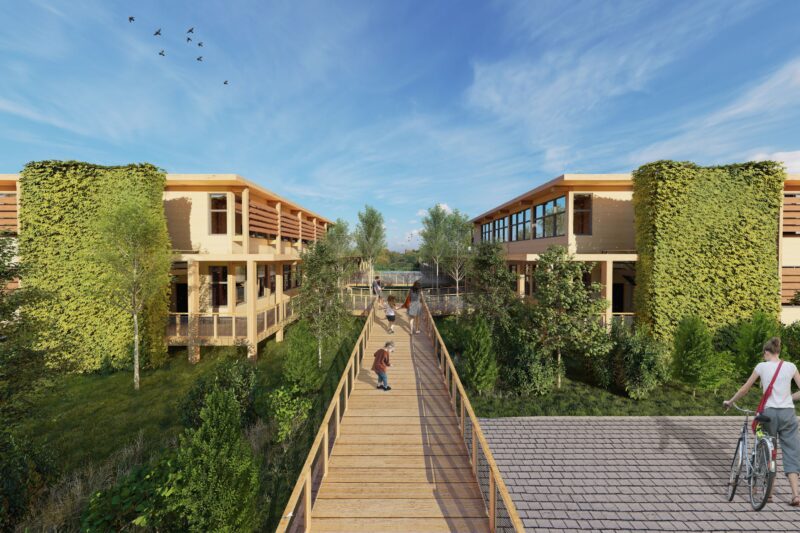
The good news is that there are clear signs of solutions emerging. The rise of interest in stakeholder capitalism, purpose-led companies, impact investing and ESG investing, even allowing for the real problem of ‘ESG washing’, are all positive trends. We see impact investing, investing with an explicit intention to make positive change, along with its corollaries of impact management and impact consuming as the way forward. Our work had always been focused on making a positive environmental impact through improving energy efficiency and when we organised our various companies into ep group we ensured that impact measurement was baked into our operating model. As we were increasingly expanding into other areas we also re-considered our purpose and stated it as follows: ‘to enable maximum impact in the transition to a net zero and regenerative economy in an equitable way’.
It is worth explaining this purpose in more detail. The word ‘enable’ is important as we think maximum impact will be achieved by focusing on enabling many people to have their own impact in their own way, rather than just focusing on our direct impact. This is what Carol Sanford, a leader in regenerative thinking, calls ‘indirect work’. The idea of a ‘net zero’ carbon economy and the need to move towards it to combat climate change is widely understood, but the phrase ‘regenerative economy’ less so. Essentially it means moving investment and resources into systems that restore and regenerate nature, systems that pay attention to quality and well-being and rely on renewable energy flows and the circular economy. The words ‘in an equitable way’ are also vital in this context, much of the modern economy is inequitable, particularly the provision of capital, much of which is extractive, short-term, and not accessible to many people. Being equitable is core to who we are.

So how are we delivering against our purpose? Our Theory of Change identifies three types of impact we have through our work: increased capacity within organisations to transition to the net zero and regenerative economy; increased investment into net zero and regenerative projects, programmes and companies; and developing and delivering high performance net zero and regenerative projects and programmes in industry and the built environment. Our services, which include: consultancy, research and development; asset management; developing projects; and architecture and design, all contribute to these impacts. Our 2022 impact report, which will be published soon, will summarise some of the impact our work has had across the different businesses.
We have another fundamental belief, and that is mainstream shareholder primacy models of business are clearly part of the problem and that introducing new models of ‘enterprise design’ is a necessary part of the solution in addressing environmental, social and governance problems. Having reviewed different models in use that address the problem, we decided to transition to steward ownership. Steward ownership is based on two principles:
- Self-governance – businesses should be controlled by people working in them.
- Profits serve purpose – profits serve the mission of the company.
Steward ownership will provide a long-term, stable home for the people in the business as well as reward them with a stake in the business.
As well as restructuring we have invested heavily in systems for governance, finance, and impact reporting. Having built our platform the strategy is to scale by agglomeration – bringing into the group other service businesses in adjacent markets that support the transition to a net zero and regenerative economy – and list the company in three to five years. This strategy provides a route to greater value creation and liquidity for business owners, access to cheaper patient capital, the ability to bid for larger projects with large customers, the network effects that can come from working with other parts of the group, and a long-term purpose-led home for their company and their employees.
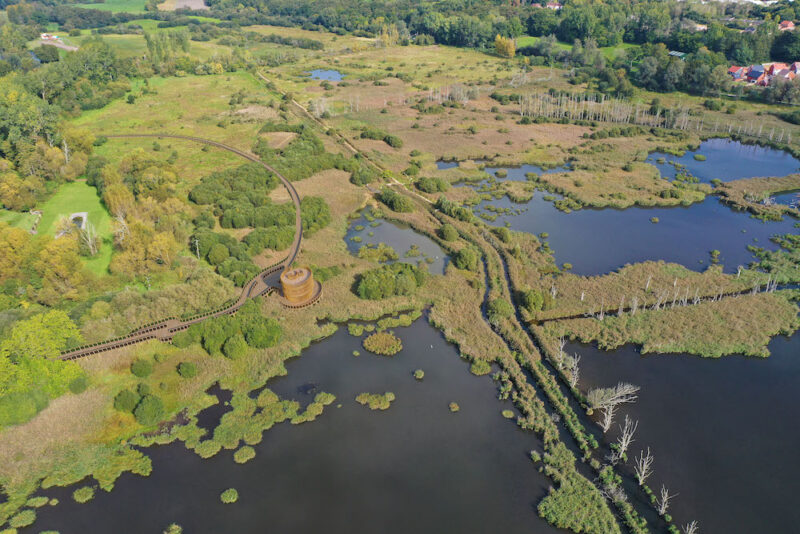
Our approach to bringing companies into the group is to first acquire at least 51% of the company in exchange for shares in ep group. The remaining shares will be purchased on an agreed exit multiple after an agreed time, or when the group lists. It is expected that the founder shareholder(s) will stay active in the business for an agreed period but it is not necessary that they should exit completely.
Companies that we bring into the group should:
- be operating in areas that support the Sustainable Development Goals, particularly SDG 7, SDG 9, SDG 11, SDG 12, and SDG 13
- be operating in areas that are complementary to existing ep group
- be EBITDA positive
- have little or no debt
- have founders seeking value realisation within a defined period
- have a complementary culture.
Our offering has proven to be attractive to business owners and we have a pipeline of companies interested in joining the group. It is also attractive to investors, particularly impact investors who cannot normally access the smaller companies which are helping to deliver the transition to a net zero and regenerative economy.
If you are interested in joining us on our journey building a new type of enterprise, or finding out more about the impact-led investment opportunities we have, do get in touch.
Steve Fawkes
Managing Partner
24 October 2022
Tuesday 4 October 2022
Anyone funding a project, or looking to investor loan money to a project or a company, should consider energy efficiency first.
There are two basic scenarios to think about:
- Energy supply projects or assets
- Energy consuming projects or assets
For all energy supply projects it is possible, and necessary, to ask whether the capital would be better deployed, where ‘better’ is defined as better or the same returns but with greater impact on energy supply and carbon emissions. In many cases investing in energy efficiency may produce better returns, optimize capital across the energy system, and produce more energy services over the life of the investment. Of course developing and implementing energy efficiency projects on the scale of energy supply projects, which are typically in the range of 10s of millions to billions of euros/pounds/dollars is not easy and we need to develop more capacity and know-how in this area.
For any consuming project or asset, which basically means nearly all buildings, manufacturing processes and plants, and all transportation systems, the question to ask is ‘are there opportunities to improve the energy efficiency of this project or asset cost-effectively that are not being exploited?’. Note that cost-effectiveness is defined by the investors’ required rate of return rather than some arbitrary number. Almost certainly there will be opportunities to improve energy efficiency, either by changing the design of the whole thing, or sub-systems within it if it is a new project or asset which is yet to be constructed or by retrofit and refurbishment opportunities if it is an existing asset.
Financial institutions which are committed to net zero, and which therefore should be committed to energy efficiency first, need to be asking these questions of all potential investments or loans. Furthermore, they need to be considering:
- how they can assist project sponsors or developers to bring forward projects in which these questions have already been answered.
- What tools they need to determine whether the answers being given to the questions are robust.
In emerging economies, where demand for basic energy services is growing rapidly, the balance between energy supply and energy efficiency investment may be different than in a mature economy, but the questions should still be asked and global experience shows that there are many opportunities for cost-effective energy efficiency in emerging economies, perhaps even more than in mature economies. Increasing the flow of capital into these opportunities can reduce energy supply constraints and make each dollar of investment into energy supply more effective in meeting energy needs and supporting SDG 7.
Friday 30 September 2022
I was honoured to be invited to attend the recent INSIGHT 2022 event organised by Convergence Energy Services Ltd in Delhi and speak on a panel. The event was sub-titled; ‘International Conference on Sustainable and Innovative Finance for Green and Healthy Transportation’.
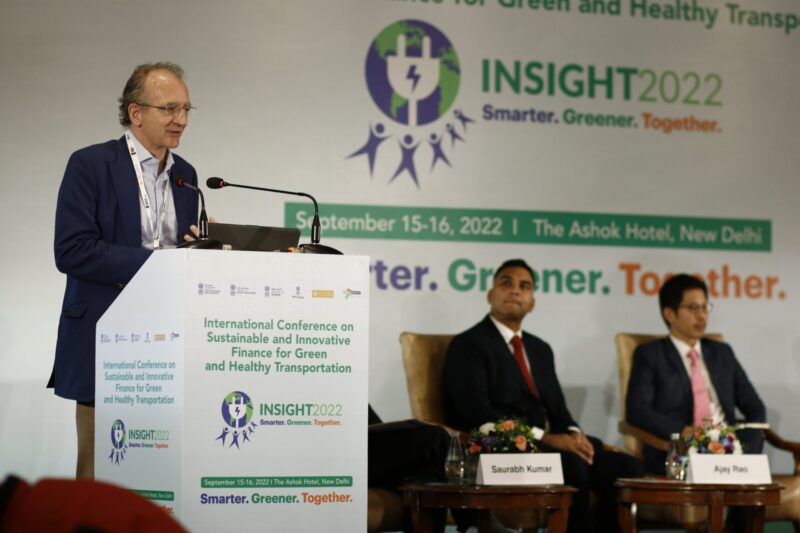
India is committed to decarbonisation and having achieved a lot in scaling energy efficiency and renewables and is now turning to focus on e-mobility. Convergence Energy Services Ltd (CESL), a subsidiary of publicly owned Energy Efficiency Services Ltd (EESL), (with which EnergyPro – part of the ep group – has a JV in the UK), recently ran a tender for 5,450 e-buses, the world’s largest e-bus procurement exercise. CESL aggregated demand across five cities and standardised tender conditions to procure e-buses on a Gross Cost Contract (GCC) basis. Developing the tender required active consultations between transit agencies, all with their own specifications, e-bus manufacturers, financiers, Ministries and government agencies. For comparison, in Europe there are about 10,000 e-buses.
Demand aggregation increased the tender size to 5,450 buses in lot sizes of 465 to 1,500 as opposed to the smaller lots of 300 buses helped OEMs achieve economies of scale. Daily running requirements of 200 km per day, or 70,000 km annually, also helped lower the bidding rates. Batteries account for c.40% of the cost of an e-bus. An assured time of 45 minutes between bus operations allows opportunity charging which meant batteries could be smaller, which helps to reduce costs. Electricity and labour costs were benchmarked to ensure transparency in the bid rates.
The demand aggregation led to a 30% reduction in the bidding prices of the Grand Challenge for 12m AC e-buses compared to GCC rates for CNG fuelled buses in Delhi. For 12m low floor non-AC e-buses are around 35% lower than the rates for 12m standard-floor non-AC CNG buses.
The 5,450 buses under the Challenge are expected to operate around 4.7 billion km over 12 years, saving 1.88 billion litres of fuel and resulting in a reduction of tail-pipe emissions of 3.31 MTCO2e.
The Grand Challenge results are an important lesson for other countries or regions looking to electrify public transport. The approach used by CESL seems to address the four elements of what I call the ‘the jigsaw of energy efficiency finance’, a simple model I developed a few years back after reviewing the global experience of scaling investment into energy efficiency. The jigsaw has four pieces:
Develop pipeline through
- more attractive business models
- Building development and aggregation platforms
Standardisation of
- development process
- technical solutions
- contracts
- systems & under-writing
Provide finance
- project development finance
- long-term project finance
Build capacity in:
- demand side
- supply side
- financial sector
To achieve scale all four pieces have to be put together.
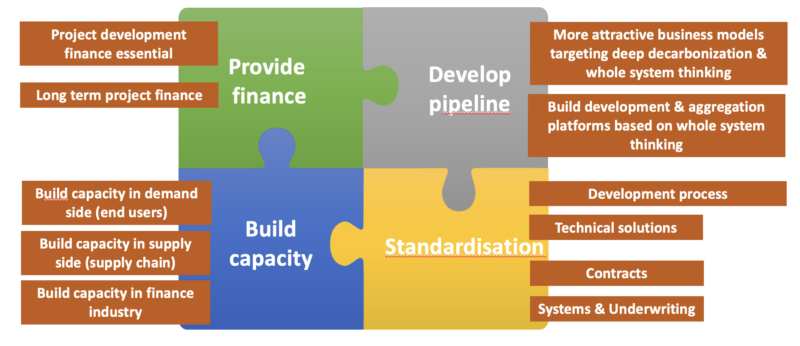
The jigsaw of energy efficiency finance. Copyright EnergyPro Ltd 2018.
In the Grand Challenge the pipeline building and standardisation pieces were performed by CESL, acting as an aggregator of demand and catalyst for getting everyone to agree the standards. Development finance was provided by CESL who were effectively acting as the project developer in this case. Finance for the 5,000+ buses came from the suppliers. CESL were the all important ‘transaction enabler’ to get all the pieces together. CESL also worked to build capacity on the demand side, the supply side and the finance side, something that is continuing.
Given the success of the Grand Challenge a target has been set by Prime Minister Modi of procuring 50,000 e-buses by 2030 and at INSIGHT 2022 there was talk of doing more and tendering 500,000. India has 1.8 million buses of which 140,000 are owned by SRTUs (State Road Transport Undertakings). Electric buses can reduce operating costs by 50% but the buses cost 2-4 times a conventional alternative. Purchasing e-bus services for a 12 year fixed contract reduces the financial and operational risks of bus agencies considerably.
The next stage of the challenge is to work how to finance the larger number of e-buses needed to really scale-up. This will require international capital and probably involve a separate agency with some form of blended capital, carbon finance and with derisking tools such as guarantees to bear some of the risks involved.
CESL’s Grand Challenge is a world leading example of the power of aggregating demand which has scope for replication in different areas including e-mobility and energy efficiency. Huge congratulations to CESL for getting the world’s largest e-bus tender completed.
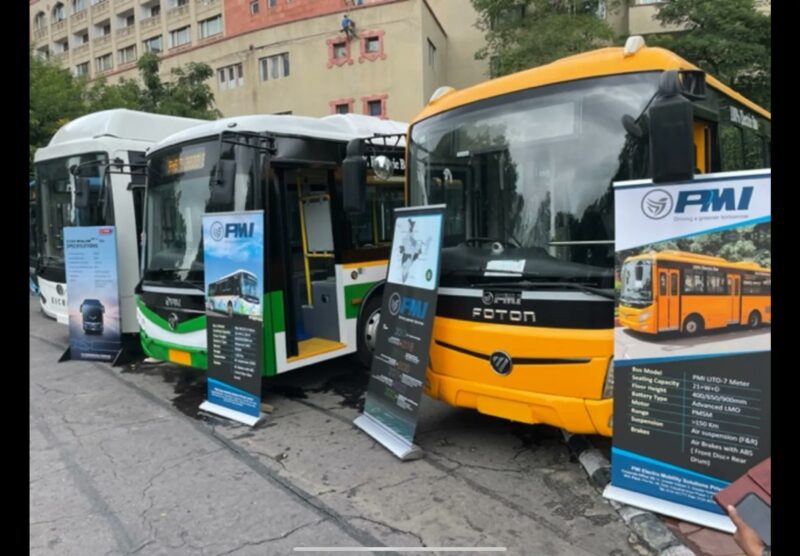
Wednesday 31 August 2022
The war in Ukraine, which now seems as if it will last a long-time, is one of the most important threats we face. Preventing, or in this case, correcting, the illegal annexation of a sovereign country by another country is fundamental and if Russia gets away with it, Europe and the world will be a more dangerous place. As everyone knows Russia can only act like this because of the huge inflows of money that result from selling gas to Europe. I wrote about energy security several times in 2013/14 – particularly when Russia invaded Crimea. I think back then Europe was sending Russia more than €0.5 billion a day (a day!) in return for oil and gas supplies. Just imagine a pile of a half a billion euros being carted off to Russia, (I know it is done electronically in reality).
Of course, energy security is not a new issue. We had the oil crises of 1973 and 1979 which highlighted dependence on oil from the Middle East. Trade is generally a good thing but by being energy dependent a country reduces it’s degrees of freedom of action. It has been good this time round that there has been concerted action in the EU at least to reduce dependence on Russian gas. Improving energy efficiency has always been, and remains one of the most powerful, and potentially quickest acting, levers that we have to reduce energy dependence. Obviously increasing domestic production of energy, of whatever source, is the other lever.
The EU through its RepowerEU initiative aims to bring down consumption by 15% by March 2023. For some reason the UK is almost alone is not responding to the war in Ukraine with a programme of at least encouraging, if not mandating energy saving despite the fact that in the UK 38% of gas is used for domestic heating and we are heading for a very hard winter that will see millions of people and businesses unable to pay their energy bill. Still, the government refuses to give any advice and only continues to issue anodyne press releases saying supplies are not threatened.
One of the really effective, and interesting things that has emerged is how much gas most homes are wasting, even the millions that have condensing boilers. When condensing boilers were introduced they were sold, and ultimately mandated, on energy saving grounds. Now it turns out – perhaps no surprise – that most of them have not been set up properly and are wasting 6-8%. This waste can be prevented by turning down the flow temperature, see here for details.
This conversation about boiler flow temps, which I’m glad to see is being turned into action, is a reminder that good energy management (for organisations or homes) consists of first managing what you have already got and then, and only then, considering investment opportunities, which can either be adding something to an existing system e.g. better controls on a heating system or lighting, or replacing something eg replacing a boiler with a heat pump, or conventional lighting with LEDs.
We learnt the basics of energy management in response to the oil crises of the 1970s (and before that the UK fuel crisis of the late 1940s) but somewhere along the line, as energy prices fell and incomes rose, they were largely forgotten. It is good to see them re-emerging, just disappointing that it takes another crisis.
The fact that homes with condensing boilers can save c.8% of gas consumption through simple re-adjustment of flow temperature shows two things:
1. The potential for cost-effective energy efficiency is still very large. At any one time, the cost-effective potential for reducing energy is probably 25-30% – and that has never changed, it is about ‘slack’ in the system. With higher prices the cost-effective potential increases. That 25-30% can usually be achieved with low cost measures and is before you get to the harder, more expensive stuff. I recently saw examples of schools saving 25%+ through low cost sensors that highlighted times of waste e.g. running heating when the building was closed or very early start times that were not justified by the weather.
2. The gas boiler industry has, with some notable exceptions, been woeful in its quality standards, training & integrity. What was the point of installing condensing boilers and claiming all the savings they were producing when they weren’t most of the time. Improving skill levels is essential, but is so improving basic integrity at senior levels within big organisations.
The idea that the government can’t or won’t do anything to give advice on energy saving is such nonsense, doing so would be an example of leadership, something that current politicians don’t seem to understand. Any information campaign does not have to be ‘authoritarian’ or ‘condescending’ – at the end of the day it is up to people whether they follow the advice but there is a real need for advice.
A case study. Back in the late 1980s I designed & ran an energy motivation programme for 45 of Coventry’s social services homes, mainly elderly people’s homes. These are some of the most difficult facilities to address in a way because: a) they are kept warm (usually too warm) all the time because residents are often sedentary and ‘need’ a high temperature – (or at least that was the belief structure) – and staff are non-technical, and they are rightly focused on their primary mission of administering care, often in difficult circumstances.
With the input from a wide range of stakeholders including the union we designed a motivation programme with a training course that:
1. explained WHY saving energy was important (which was all about budgets then, as it was pre conversations about carbon)
2. explained HOW to save energy, the usual simple tips
3. explained how to read meters (which is never easy) and record consumption (there were no smart meters back then).
Using the meter data we then gave them regular, simple weather corrected feedback (having explained how it worked), and the establishment received a percentage of the proven savings to spend on stuff that benefited the home. Often they spent it on additional simple energy saving measures, like draught proofing, adding a porch, etc., or on little niggly maintenance jobs that they had not succeeded in getting done through the system.
The net result was an overall 6% savings on energy use over a year, with individual savings ranging up to 38%. All of this was with no capital expenditure. The result was financial, energy, and carbon savings and engaged staff.
We developed a simple model which seems to work. In order to create Action, you need 2 things: Knowledge (or know-how) of what to do and the Motivation to do something. Training provides know-how and when done well can increase Motivation. Motivation is also (greatly) increased by Incentive, (which does not have to be financial), and Feedback that shows that the action is having the desired effect. Put those things together and you have effective action.
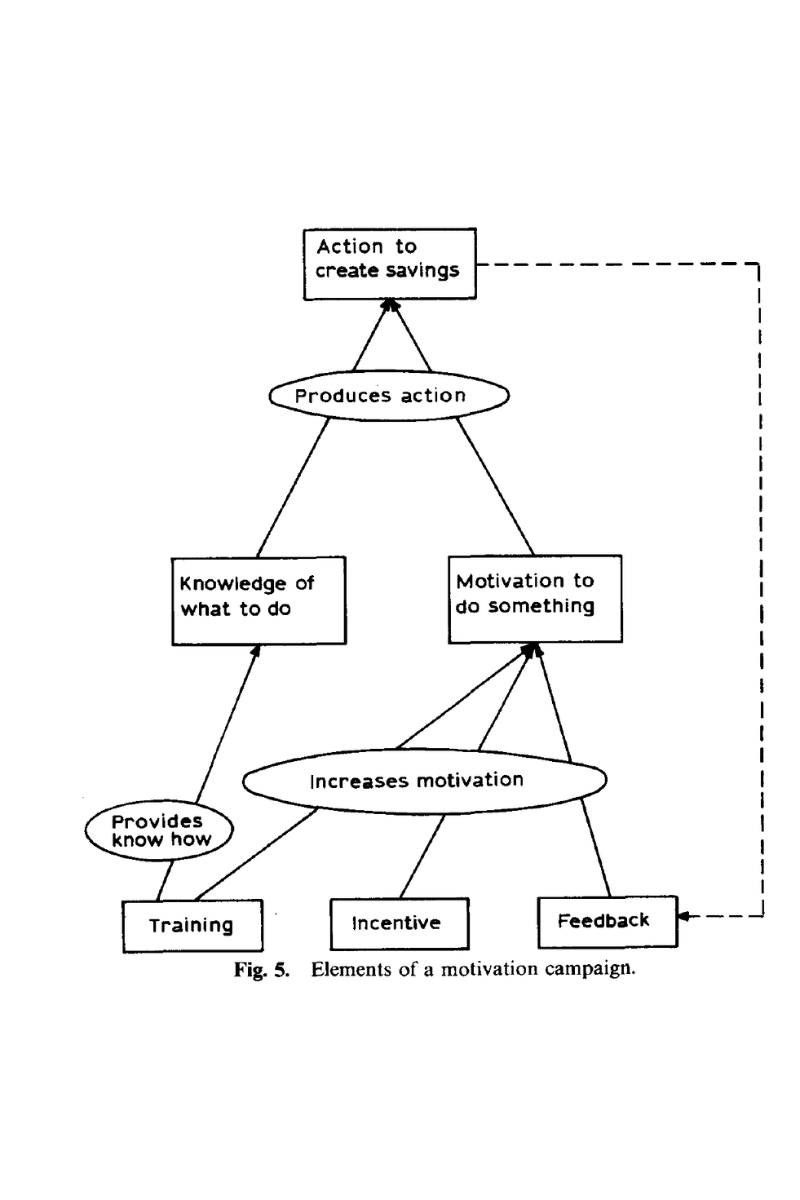
Other motivation campaigns at the time gave a percentage of savings to a charity chosen by the end-users, thus creating a double impact.
If we could do that with basically no technology, other than a spreadsheet, imagine what smart meters and cheap smart sensors can do. The schools saving 25% through smart sensors I referred to above are good examples.
We should be getting our energy management basics right before considering capital projects. Optimising energy consumption first can change what is viable or optimum for the capital projects, as well as reduce capital through techniques such as right-sizing. The differences between the 1980s and now are essentially: better technological options, increased motivation, and decarbonisation of electricity. When considering capital expenditure options the combination of climate change and the war in Ukraine should drive everyone to consider what would once have been considered radical, higher cost options including electrification and deep retrofits, rather than small improvements. At today’s prices many of these measures will be economic, the problem then is how to finance them, particularly in the residential sector. When assessing financial benefits we should also never forget, although most people do, the impact of energy price volatility, which in itself has a financial impact, irrespective of the energy price being made.
We know what to do to reduce dependence on dictators selling fossil fuels, along with all the other negative environmental, economic, and social impacts from their use. Let’s just do it.
The Coventry project is described here.
Wednesday 15 June 2022
This book sets out the issues that company boards face in the light of climate change and the wider set of factors that fall under the ESG banner, and provides useful advice for boards at all levels. It is clear that climate change, the drive to net zero, and the rapid rise of ESG investing creates many new problems for boards to consider and there is an urgent need to upskill boards to deal with them adequately. All of these factors are also in the context of a fundamental shift away from the shareholder primacy model of capitalism towards a broader model of stakeholder capitalism, the exact forms that this shift takes is not yet totally clear and there may be multiple models.
The book sets out the context and explores specific issues including amongst others; the SDGs, gender diversity; corruption; and managing responsibility in supply chains. As well as setting out the context of each of these the book provides useful examples of how to deal with them and recommendations for action.
My only criticism of the book is that it seems to assume all ESG investing is equally good, even though it is clear that there are degrees of ‘ESG washing’ and not all ESG investors or funds are applying truly rigorous standards. Having said this the direction of travel of the finance sector is clear and the shift towards ESG and impact investing is already having a massive impact on boards of companies of all sizes. As well as the requirements for larger companies to comply with regulations such as the Sustainable Finance Taxonomy, smaller companies are increasingly being asked by customers to demonstrate their ESG performance.
This book is a very useful guidance for board members getting to grips with these increasingly important issues and the work of Helle Bank Jorgensen through Competent Boards is to be commended.
At ep group we are impact led and working hard to integrate consideration of all of our impacts into our decision making. Because we believe in long-term stewardship and the need to re-adjust the relationship of capital to companies as part of the move towards a new form of stakeholder capitalism and enterprise design, we are transitioning to steward ownership. We will certainly use this book in increasing our knowledge and skills.
Dr. Steven Fawkes
Managing Partner
ep group
6th June 2022
Dr Steven Fawkes
Welcome to my blog on energy efficiency and energy efficiency financing. The first question people ask is why my blog is called 'only eleven percent' - the answer is here. I look forward to engaging with you!
Email notifications
Receive an email every time something new is posted on the blog
Tag cloud
Black & Veatch Building technologies Caludie Haignere China Climate co-benefits David Cameron E.On EDF EDF Pulse awards Emissions Energy Energy Bill Energy Efficiency Energy Efficiency Mission energy security Environment Europe FERC Finance Fusion Government Henri Proglio innovation Innovation Gateway investment in energy Investor Confidence Project Investors Jevons paradox M&V Management net zero new technology NorthWestern Energy Stakeholders Nuclear Prime Minister RBS renewables Research survey Technology uk energy policy US USA Wind farmsMy latest entries
- The journey to net zero
- The RetroMeter project: using metered energy savings to make energy efficiency more investable
- An overview of the ESCO industry
- Applying Energy Efficiency First in financial institutions
- Getting to grips with the complexities of industrial decarbonisation using soft systems
- Back in Brum – home of the Energy Service Company
- Net Zero: A New Front in the Culture Wars?


